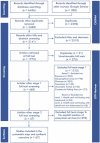Evidence on the impact of Baltic Sea ecosystems on human health and well-being: a systematic map
- PMID: 34777788
- PMCID: PMC8572082
- DOI: 10.1186/s13750-021-00244-w
Evidence on the impact of Baltic Sea ecosystems on human health and well-being: a systematic map
Abstract
Background: While the unique marine and coastal environment of the Baltic Sea provides numerous ecosystem services, its ecosystems are under pressure due to the intensification and diversification of anthropogenic uses. This present work constitutes a systematic map of the evidence of the impacts of ecosystem services and disservices on human health and well-being. The aim is to create a better understanding of the threats of unsustainable management or the benefits of sustainable management of the Baltic Sea and the impacts these may have on the health and well-being of human populations and present these findings to policy advisors. The mapping process is described, and the characteristics of the evidence base are presented.
Methods: The applied method has been previously published in a systematic map protocol. Literature searches were carried out in English considering published peer-reviewed literature from traditional scientific journals and scientific reports from the grey literature, using synthesis software. A total of 17 databases were searched. Articles were screened in stages at title and abstract stage, then full-text stage. Geographic limitations were placed on the searches in accordance with research funders call, however, watersheds that had an impact on the Baltic Sea marine and coastal regions were considered. We used the more open PEO format, where population (P) included the human populations within the marine and coastal environment of the Baltic Sea region, exposure (E) related to the Baltic Sea ecosystems services and disservices, and the outcome (O) included all aspects of human health and well-being. After full-text screening articles selected for inclusion were searched for metadata connected to bibliographic information, ecosystem services, health and well-being outcomes and policy relevance.
Review findings: Out of 6456 hits only 460 studies discussed either health or well-being indicators to some extent. Of these, only 67 explicitly mentioned ecosystem services and health and well-being indicators. However, few in this subset engaged with the topic of ecosystem services or disservices and health and well-being in depth. Studies are increasingly relating the two concepts but currently it is mainly studies focussed on cultural ecosystem services that deal with the concept of health and well-being to a greater degree. Studies in the medical literature relating to impacts on health from exposure to the Baltic Sea did not relate their findings to ecosystem services. The database of 67 studies is attached as Additional file 5.
Conclusions: Ecosystem services play an important role in human health and well-being; however, we found few studies that explicitly examine these impacts in detail. Further research is needed to link the health and well-being outcomes from the Baltic Sea to the ecosystem services supplied and therefore to demonstrate the benefits and disservices provided by the Baltic Sea ecosystems to human populations.
Supplementary information: The online version contains supplementary material available at 10.1186/s13750-021-00244-w.
Keywords: Ecosystem services; Evidence synthesis; HELCOM region; Marine and coastal environment; Participatory approach; Policy relevance.
© The Author(s) 2021.
Conflict of interest statement
Competing interestsThe authors declare that they have no competing interests.
Figures


















Similar articles
-
Existing evidence on the impact of changes in marine ecosystem structure and functioning on ecosystem service delivery: a systematic map.Environ Evid. 2023 Jul 20;12(1):13. doi: 10.1186/s13750-023-00306-1. Environ Evid. 2023. PMID: 39294771 Free PMC article.
-
Beyond the black stump: rapid reviews of health research issues affecting regional, rural and remote Australia.Med J Aust. 2020 Dec;213 Suppl 11:S3-S32.e1. doi: 10.5694/mja2.50881. Med J Aust. 2020. PMID: 33314144
-
Evidence for the effects of decommissioning man-made structures on marine ecosystems globally: a systematic map.Environ Evid. 2022 Nov 1;11(1):35. doi: 10.1186/s13750-022-00285-9. Environ Evid. 2022. PMID: 39294784 Free PMC article.
-
The Minderoo-Monaco Commission on Plastics and Human Health.Ann Glob Health. 2023 Mar 21;89(1):23. doi: 10.5334/aogh.4056. eCollection 2023. Ann Glob Health. 2023. PMID: 36969097 Free PMC article. Review.
-
From ecosystems to socio-economic benefits: A systematic review of coastal ecosystem services in the Baltic Sea.Sci Total Environ. 2021 Feb 10;755(Pt 2):142565. doi: 10.1016/j.scitotenv.2020.142565. Epub 2020 Sep 30. Sci Total Environ. 2021. PMID: 33059139 Review.
Cited by
-
Existing evidence on the impact of changes in marine ecosystem structure and functioning on ecosystem service delivery: a systematic map.Environ Evid. 2023 Jul 20;12(1):13. doi: 10.1186/s13750-023-00306-1. Environ Evid. 2023. PMID: 39294771 Free PMC article.
References
-
- HELCOM. State of the Baltic Sea-second HELCOM holistic assessment, 2011–2016. Baltic Marine Environment Protection Commission—HELCOM.
-
- Martin CL, Momtaz S, Gaston T, et al. A systematic quantitative review of coastal and marine cultural ecosystem services: current status and future research. Mar Policy. 2016;74:25–32.
-
- European Parliament. Marine strategy framework directive (2008/56/EC).
-
- HELCOM. HELCOM Baltic Sea action plan. November; 2007.
-
- Fleming LE, Maycock B, White MP, et al. Fostering human health through ocean sustainability in the 21st century. People Nat. 2019;1:276–283.
LinkOut - more resources
Full Text Sources
Miscellaneous
